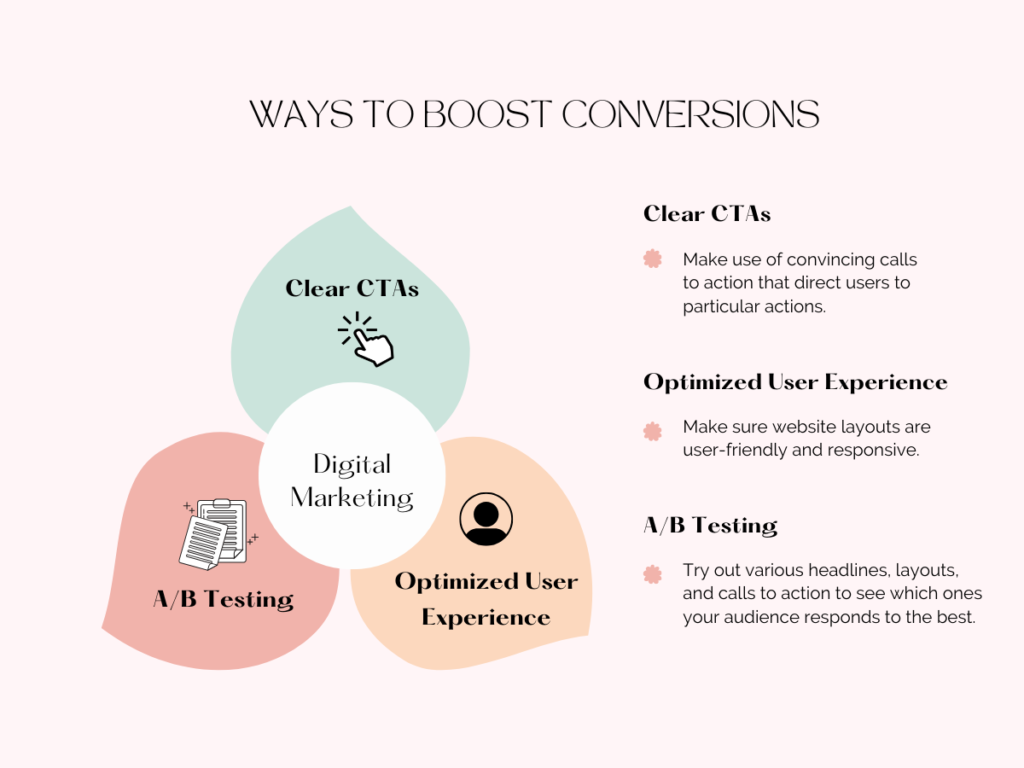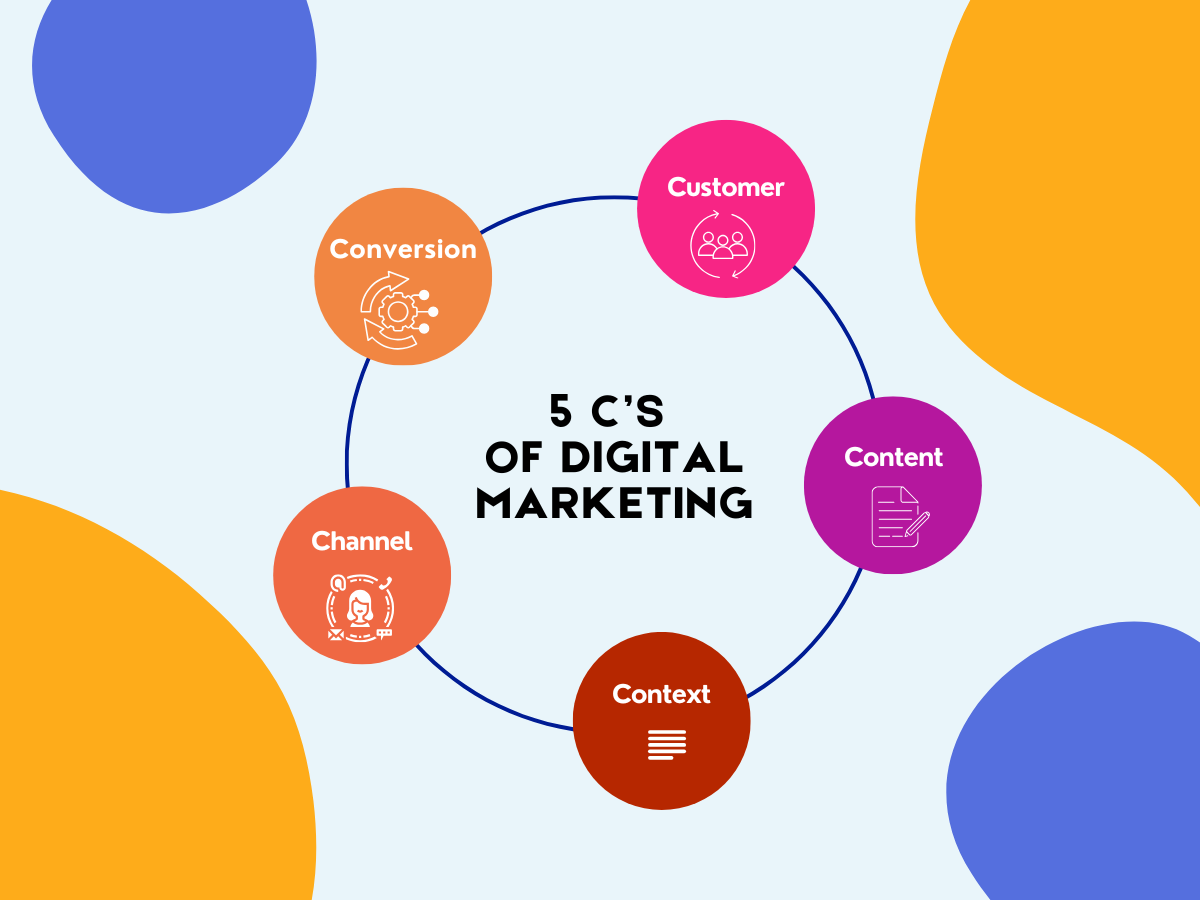A customer-centric approach and adaptation are key components of successful marketing strategies. The “5 C’s of Digital Marketing” prove helpful in this situation as they provide a thorough structure for creating campaigns that have an impact. These essential elements, Customer, Content, Context, Channel, and Conversion, address significant elements of audience engagement, retention, and conversion.
1. Customer: Customers are at the center of any digital marketing strategy. Their preferences, behaviors, and pain points inform how marketers create a personalized experience that speaks to customers and builds loyalty.
2. Content: This attracts people to your site, educates them, and fosters trust. Blogging, video, infographics, and social media posts are the formats tailored to attract and educate the customer and keep them engaged.
3. Context: Relevant marketing involves communicating the right message to the target audience at the right moment. Contextual campaigns would consider market trends, the intent of users, and seasonal dynamics so as to achieve maximum relevance and impact.
4. Channel: Choosing the appropriate channel is critical in reaching out to the audience. Platforms include social media, emails, search engines, and display advertisement that connect a brand with its target markets.
5. Conversion: The ultimate measure is to convert interest to action. Clear calls to action, user-friendly experience, and data-driven optimization in order to drive measurable outcome.
Understanding the five C’s allows companies to match their digital initiatives with customer demands, guaranteeing long-term success and growth.
The 5 C’s of Digital Marketing Explained in Depth
1. Customer: The Foundation of Digital Marketing
The core of any effective digital marketing plan is a thorough understanding of the consumer. Providing meaningful and successful marketing is practically impossible without an extensive understanding of your audience.
Why it Matters:
- Businesses can address specific requirements, pain areas, and preferences by adopting a customer-centric approach.
- Customized techniques promote lifelong loyalty and trust.
Key Steps to Understand Customers:
- Developing Buyer Personas: Thorough profiles that describe the characteristics, habits, and desires of customers.
- Collecting Data: To gain firsthand knowledge about consumer experiences, undertake focus groups, surveys, and interviews.
- Behavioral Analytics: Examine user engagement, website traffic, and buying habits using tools such as Google Analytics.
2. Content: The Heart of Engagement
Content is what builds credibility in your field, engages consumers, and increases online visibility. Even the best-laid marketing initiatives might fail if they lack relevant, high-quality content.
Why Content is Critical:
- Attraction: People visit your website or social media pages when you have captivating content.
- Education: It educates prospective clients about your services and areas of competence.
- Retention: Regular and excellent content promotes loyalty and promotes return visits.
Types of Effective Content:
- Written: eBooks, articles, and blog entries that respond to the questions and concerns of the readership.
- Visual: Videos and infographics that make difficult concepts easier to understand.
- Interactive: Live webinars, polls, and quizzes that involve users directly.
Tips for Outstanding Content:
- Prioritize value above progress.
- Use appropriate keywords to optimize for search engines.
- To engage your audience, speak in an informal way.
3. Context: Delivering the Right Message
With the delivery of the appropriate message at the right time and location, context increases the impact of your content.
Why Context Matters:
- By optimizing user experiences, it increases the relevance and interest of campaigns.
- By fulfilling present client demands, contextual marketing increases conversion rates.
Key Elements of Context:
- Personalization: Customize offerings and content based on consumer data.
- Timing: Match campaigns to significant occasions, prevailing patterns, or user actions.
Examples of Contextual Marketing:
- Holiday Promotions: During holidays, retailers run themed marketing.
- Behavior-Based Recommendations: Online retailers make suggestions for products based on users’ browsing or past purchases.
4. Channel: Reaching Your Audience Effectively
The information you provide will reach your audience where they have the greatest interest if you choose the appropriate channels. The decision you make will have a significant impact on how well your digital marketing campaign works.
Popular Digital Channels:
- Social Media: Direct interaction is possible on sites like Facebook, Instagram, and LinkedIn.
- Search Engines: PPC and SEO initiatives increase exposure and bring in relevant traffic.
- Email Marketing: Targeted email campaigns improve client relationships and cultivate leads.
How to Choose the Right Channel:
- Align channels with your target audience. For example, Instagram works well for brands aiming to reach younger audiences, while LinkedIn is best for B2B companies.
- To optimize channel utilization and track performance, use analytics.
- To find the ideal combination for your objectives, test several multi-channel strategies.
5. Conversion: Turning Interest into Action
The most important goal of digital marketing is conversion. Every strategy, whether it’s making a purchase or subscribing to a newsletter, seeks to turn occasional visitors into loyal customers.
Why Conversions Matter:
- They show how successful your campaigns were.
- High conversion rates are a sign of high user confidence and enthusiasm.
Ways to Boost Conversions:

- Clear CTAs: Make use of convincing calls to action that direct users to particular actions.
- Optimized User Experience: Make sure website layouts are user-friendly and responsive.
- A/B Testing: Try out various headlines, layouts, and calls to action to see which ones your audience responds to the best.
How the 5 C’s Work Together
Customer, Content, Context, Channel, and Conversion—the five C’s of digital marketing, form an interconnected structure that drives successful strategies. As each element works well with the others, campaigns have one voice and focused on achieving certain goals.
By identifying the requirements, tastes, and behaviors of the audience, client comprehension serves as the cornerstone. This understanding directs the production of content that successfully connects, engages, and informs the audience. Timing, customisation, and relevancy are key factors in maximizing the impact of this material and building stronger relationships with the audience.
Channel selection ensures the message hits the target where it will be most active. Be it social media, emails, or search engines, final conversion focus helps in converting audience engagement into concrete sales, subscriptions, or inquiries.
The 5 C’s in practice combine to provide an all-around approach that elevates the effectiveness of campaigns for digital marketing. Sustainable growth, customer loyalty, and strong digital presence could be attained by constantly referring to and fine-tuning each one of these factors.
How the 5 C’s Enhance Digital Marketing Success
The 5 C’s of digital marketing—Customer, Content, Context, Channel, and Conversion, are a structured framework for the development of effective campaigns. These elements are interconnected in such a way that a business can ensure a well-rounded, customer-centric approach.
Customer-centric strategies have to be prioritized to improve engagement, because such efforts are aligned with the audience’s needs and preferences. Content that is value-adding helps build trust and authority while targeting specific pain points of customers. It is also essential to ensure that this content fits the right context, like the timing and personalization.
It would also select appropriate channels, including social media, email, or even search engines, for optimal transmission of the message. It also focuses on conversion efforts that would result in measurable outcomes such as lead generation or sales.
Taken altogether, the 5 C’s form a holistic approach, building customer relationships, bolstering brand presence, and success in a competitive environment of digitalization. Having mastered this framework will set businesses on the road toward sustained growth and meaningful communication with their audience.
Integrating the 5 C’s into Your Digital Marketing Strategy
To integrate the 5 C’s into one’s digital marketing strategy, appropriate planning and execution are fundamental. Start with market research to define the target audience as well as creating detailed descriptions of buyer personas, understanding how they like to be sold to, and using analysis tools to monitor behaviors or trends. In this respect, the approach is truly customer-centric, targeting explicit needs.
Plan a content calendar for your marketing. Include quality and relevant content that relates to the needs of your audience, as well as current industry trends. Keep using different formats such as blogs, videos, and infographics to maintain interest and extend reach.
Leverage analytics to know which of your channels are high performing and therefore optimize your campaign. Using tools such as Google Analytics or social media insights can determine which platforms actually produce more traffic and conversion. Use data like that to allocate the most resourceful channels producing the best results, which would help make your effort worthwhile.
Finally, align all activities to the goal of conversion rate increase. Make clear calls-to-action, monitor performance, and continually refine your strategy through A/B testing and feedback. With the integration of the 5 C’s, you can develop a streamlined digital marketing approach that drives engagement, enhances customer relationships, and delivers measurable results.
FAQs
What are the 5 C’s of digital marketing?
The 5 C’s are Customer, Content, Context, Channel, and Conversion. They form the framework for crafting successful digital marketing strategies.
Why is understanding the customer important in digital marketing?
Understanding your customer allows you to tailor messages, products, and campaigns to their preferences, improving engagement and conversions.
How does content contribute to a successful marketing campaign?
Content informs, attracts, and retains customers. High-quality content builds trust and authority, encouraging brand loyalty.
What is the role of context in digital marketing?
Context ensures that the right message is delivered at the right time, improving its relevance and effectiveness.
The most effective channels depend on your target audience but typically include social media, email marketing, and search engines.
How can businesses improve conversion rates?
Businesses can improve conversions by using clear CTAs, optimizing website designs, and conducting A/B testing to refine strategies.
Are the 5 C’s suitable for small businesses?
Yes, the 5 C’s framework can be scaled to fit any business size, ensuring targeted and efficient campaigns.
How do the 5 C’s interact with each other?
They are interdependent, creating a cohesive strategy that aligns customer needs with content, context, channels, and conversions.
What tools can help implement the 5 C’s?
Tools like Google Analytics, content management systems, and social media platforms assist in executing the 5 C’s effectively.
Why is it important to use multiple digital marketing channels?
Using multiple channels expands your reach, engages diverse audiences, and increases the likelihood of achieving conversions.


Comments are closed